 |

Botanical Society of the British Isles
Field Meeting in the Valle de Benasque
led by Teresa Farino and Stuart Hedley
25 June - 1 July 2008
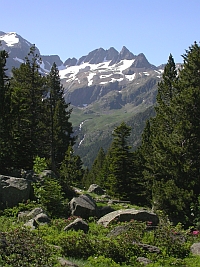 Valle de Benasque © Teresa Farino Valle de Benasque © Teresa FarinoTwelve BSBI members joined leaders Teresa Farino and Stuart Hedley for a week to explore the Posets-Maladeta Natural Park and valley of Benasque, in the Aragonese Pyrenees. Heavy falls of snow around Easter, followed by six weeks' rain during May and the early part of June meant that the flora we encountered was more typical of late May than late June, with several species of Narcissus still in flower. Nevertheless, splendid weather accompanied us during the week, with the exception of a violent hailstorm on the final day, and we saw more than 500 species of vascular plant, including a large number of Pyrenean endemics.
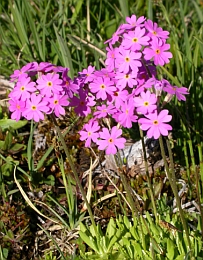 Bird's-eye Primrose
Bird's-eye Primrose
Primula farinosa
© Teresa Farino
25 June - Plan d'Están
Our first morning dawned fine and clear, with an air of excitement and anticipation among us. All around us were magnificent
views of snow-capped mountains, with bright ribbons of mountain streams tumbling through dark pine forests to the intense green
of the valley floor. We drove northwards up the classic U-shaped glaciated valley of the Río Ésera, soon leaving behind the
rapidly-developing, but still small and compact village of Benasque, our base for the week.
Our first stop was initiated by a slow-moving herd of beef cattle moving up to their summer pastures, which occupied the
whole of the road ahead. A lush road-side meadow provided us with an interesting tall-herb assemblage of Trollius europaeus
(Globeflower), Astrantia major (Astrantia), Salvia pratensis (Meadow Clary), Phyteuma orbiculare (Round-headed Rampion)
and Valeriana officinalis (Common Valerian), with the shorter marginal sward hosting the first of many Platanthera chlorantha
(Greater Butterfly Orchid) and a few 'gone-over' Coeloglossum viride (Frog Orchid).
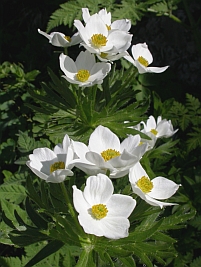 Narcissus-flowered Anemone
Narcissus-flowered Anemone
Anemone narcissiflora
© Teresa Farino
Once the road was clear, we headed up to the top of the valley and then eastwards through some very disturbed metamorphic
rocks to an area of limestone outcrops above Los Llanos de l'Hospital - always good for plant growth and diversity - surrounded
by more acid boggy areas. A huge variety of plants was seen here, comprising a mixture of European, Alpine and British native species.
For examples of the latter, looking larger, better and brighter than our own, we saw Helleborus viridis (Green Hellebore),
drifts of Primula farinosa (Bird's-eye Primrose), Geum rivale (Water Avens), Potentilla rupestris (Rock Cinquefoil; protected
in the UK by Schedule 8 of the Wildlife and Countryside Act, 1981, but relatively common in this part of Spain), Anthyllis
vulneraria (Kidney Vetch), in its alternative strip of an attractive shade of pink, and Gentiana verna (Spring Gentian).
Continental and Alpine species included the delightful Anemone narcissiflora (Narcissus-flowered Anemone), Arenaria
tetraquetra (Imbricate Sandwort), Viola biflora (Yellow Wood Violet), the lime-encrusting Saxifraga paniculata (Livelong
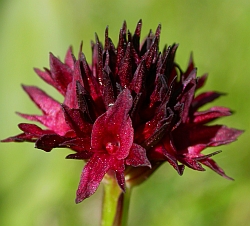 Nigritella austriaca ssp. iberica
© Teresa Farino
saxifrage) and lumps of the more tender S. moschata (White Musky Saxifrage), the charming, white-flowered Afro-Iberian endemic
Potentilla alchimilloides (Alchemilla-leaved Cinquefoil), the prostrate and sweetly-scented Daphne cneorum (Garland Flower),
Veronica aphylla (Leafless-stemmed Speedwell), the large trumpet gentian Gentiana acaulis, Aster alpinus (Alpine Aster), the
mat-forming Globularia repens and much larger G. nudicaulis(Leafless-stemmed Globularia), Brimeura amethystina
(Pyrenean Hyacinth), a few Fritillaria pyrenaica (Pyrenean Snakeshead), and many more too numerous to mention.
Nigritella austriaca ssp. iberica
© Teresa Farino
saxifrage) and lumps of the more tender S. moschata (White Musky Saxifrage), the charming, white-flowered Afro-Iberian endemic
Potentilla alchimilloides (Alchemilla-leaved Cinquefoil), the prostrate and sweetly-scented Daphne cneorum (Garland Flower),
Veronica aphylla (Leafless-stemmed Speedwell), the large trumpet gentian Gentiana acaulis, Aster alpinus (Alpine Aster), the
mat-forming Globularia repens and much larger G. nudicaulis(Leafless-stemmed Globularia), Brimeura amethystina
(Pyrenean Hyacinth), a few Fritillaria pyrenaica (Pyrenean Snakeshead), and many more too numerous to mention.
Orchids were also well represented, with Gymnadenia conopsea (Fragrant Orchid), some fresh Coeloglossum viride, the deep-red
Nigritella austriaca ssp. iberica, Orchis pallens (Pale-flowered Orchid), Orchis ustulata (Burnt Orchid), Dactylorhiza sambucina
(Elder-flowered Orchid) and Dactylorhiza majalis (Broad-leaved Marsh Orchid). While botanising we also had good views of Alpine Marmots
(Marmota marmota) - attractive, interesting, and very 'cuddly' - provoking discussion on the precise description of their alarm
calls: do they pipe, whistle, squeak, or whatever?
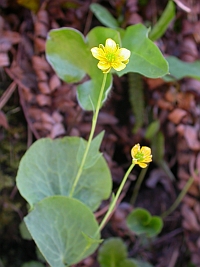 Thore's Buttercup
Thore's Buttercup
Ranunculus thora
© Teresa Farino
A lunch break was taken in a delightful shady spot near the stream. Teresa's picnics are now legendary, and this one,
the first of many throughout the week, was a stupendous feast, such that progress was somewhat slower for a time afterwards,
but we were soon refreshed by the richness of the flora. This time we headed back along the road towards the Los Llanos de
l'Hospital, stopping in more acid terrain under open Pinus uncinata (Mountain Pine) and Abies alba (European Silver-fir) forest.
The understorey here was carpeted with Rhododendron ferrugineum (Alpenrose), predominantly pink-flowered, but sometimes white,
interspersed here and there with Daphne mezereum (Mezereon), clumps of Pulsatilla alpina ssp. cantabrica, with huge white
blooms often exceeding 5cm in diameter, the shaggy lilac flowers of Thalictrum aquilegiifolium (French Meadow-rue) and the
less conspicuous Homogyne alpina (Purple Colt's-foot).
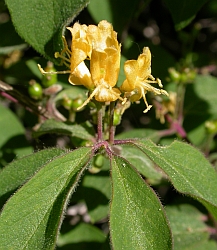 Fly Honeysuckle
Fly Honeysuckle
Lonicera xylosteum
© Teresa Farino
At the foot of a shady limestone cliff we located the curious Ranunculus thora (Thore's Buttercup), identified by its broad,
Caltha-like leaves from which emerge slender stalks topped by diminutive yellow flowers, as well as the Pyrenean endemic
Saxifraga umbrosa (Wood Saxifrage) and Scilla lilio-hyacinthus (Pyrenean Squill).
26 June - dry meadows and scrub above Benasque
A stony path, once a mule track, winds down to Benasque from the modern road to Cerler, through a sweet-smelling scrub of
decidedly Mediterranean character, dominated by Buxus sempervirens (Box), scattered Amelanchier ovalis (Snowy Mespilus)
Lonicera xylosteum (Fly Honeysuckle) and L. pyrenaica ssp. pyrenaica (Pyrenean honeysuckle), the latter an attractive
endemic with campanulate pinkish flowers.
 Snowy Wood-rush
Snowy Wood-rush
Luzula nivea
© Teresa Farino
As we wound steadily downwards, we admired many of the same orchids seen on the limestone on the first day, plus
Lilium martagon (Martagon Lily, sadly not quite in flower), and a species of Anthericum that had us very much confused: was it A. liliago (St Bernard's Lily),
or did those long-branched inflorescences mean it was the rather dubious taxon Anthericum ramosum?
Consulting the local floras didn't shed much light on the problem, as other characters such as flower size and whether the
seed capsules were globose or trigonous appeared to be exceedingly variable between branched and unbranched plants.
Other noteworthy plants here were the (misleadingly-named) Arabis pauciflora, almost always seen growing with A. turrita
(Tower-cress), the curious shrubby plantain Plantago sempervirens and the (very aptly-named) Luzula nivea (Snowy wood-rush),
with stunning white flower heads. More colour was provided by Dianthus carthusianorum (Carthusian Pink),
beneath whose flower-head Mary spotted a yellow crab-spider waited to pounce on an unwary pollinator, D. monspessulanus
(Fringed Pink), Polygala nicaeensis (Nice milkwort), Emerus major (Scorpion Senna), the yellow rest-harrow Ononis aragonensis,
the sainfoin Onobrychis supina, with its attendant Osiris Blue (Cupido osiris) butterflies, and Linum narbonense
(Beautiful Flax). One of the more distinctive broomrapes - Orobanche gracilis (Slender Broomrape) - was parasitic upon various
legumes along the way.
 Astrantia
Astrantia
Astrantia major
© Teresa Farino
The highlight of the morning was undoubtedly the species-rich hay meadows beside the path. The experience of walking through chest-high stands of Astrantia major and Laserpitium latifolium (Broad-leaved Sermountain) will not be quickly forgotten, while a close look revealed Listera ovata (Twayblade) and the semi-parasitic Thesium pyrenaicum ssp. pyrenaicum (Pyrenean Bastard-toadflax) among the stands of the yellow rattle Rhinanthus pumilus ssp. pumilus (= R. mediterraneus), itself a hemi-parasite of grasses. Delayed only slightly by the first mammal of the day, a (dead) Garden Dormouse (Eliomys quercinus), we entered Benasque past Vicia onobrychioides (False Sainfoin), Euphorbia characias (Mediterranean Spurge) and Astragalus glycyphyllos (Wild Liquorice).
Having overcome the logistical problem of retrieving our transport from the top of the hill, we drove up the valley to the water meadows of Los Baños de Benasque. The herd of cattle we had followed yesterday was by now in residence, watching our riverside lunch with interest and much ringing of cow bells. In ungrazed, rather damp areas we found the diminutive Polygonum viviparum (Alpine Bistort) and huge-leaved Rumex pseudalpinus (Monk's-rhubarb), plus Tetragonolobus maritimus (Dragon's-teeth), Lathyrus occidentalis (Yellow Pea), Bartsia alpina (Alpine Bartsia), Tofieldia calyculata (Tofield's asphodel) and Triglochin palustris (Marsh Arrowgrass), as well as plenty of Primula farinosa and Dactylorhiza majalis.
 Pyrenean Saxifrage
Pyrenean Saxifrage
Saxifraga longifolia
© Teresa Farino
On nearby lime-rich rocks there was a good display of the charming Pyrenean endemic Ramonda myconi (Ramonda), while Shirley tracked down two interesting calcicoles: the exceedingly hairy, lemon-flowered Potentilla nivalis and Sideritis hyssopifolia (Hyssop-leaved Sideritis). A more acid boulder choke turned up Mecanopsis cambrica (Welsh Poppy). The drive back gave us yet another chance to admire and photograph the enormous panicles of Saxifraga longifolia (Pyrenean Saxifrage) on cliffs near Benasque.
27 June - Forau de Aiguallut
After a night of thunder and lightening the day dawned grey and drizzly and rather cool. We drove up to the end of the Ésera valley in order to walk along the trail from La Besurta to the Forau de Aiguallut, where meltwater from the Aneto glacier disappears down a sink-hole, to reappear five kilometres way in the Vall d'Aran, on the north side of the main Pyrenean axis. En route we stopped by the roadside to see a fine specimen of Atropa bella-donna (Deadly Nightshade), where we also compared the two similar purple labiates Acinos alpinus (Alpine Calamint) and A. arvensis (Basil Thyme).
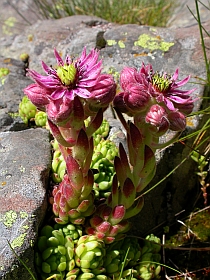 Mountain Houseleek
Mountain Houseleek
Sempervivum montanum
© Teresa Farino
In response to the persistent drizzle, thirteen members of the group started out on the trail to the Forau in waterproofs and boots, while our guide wielded an umbrella and wore her habitual sandals. She obviously had a much better idea of the local weather patterns and by mid-morning proved to be by far the most suitably clad person.
While Maurice and Dorothy welcomed the chance to stretch their legs on a proper walk at last, the botanists really had a field day. First off, under John's expert guidance, a shady boulder-choke provided us with the opportunity to compare and contrast many species of fern growing in close proximity (see Box). Drier habitats were decorated by the relatively huge flowers of Geum montanum (Alpine Avens) and Gentiana alpina (Southern Gentian) - such 'giantism' is a distinct bid to attract the rather scarce pollinators of high-mountain habitats - as well as cushions of Silene acaulis (Moss Campion) and Mountain Houseleek (Sempervivum montanum).
 Pheasant's-eye Narcissus
Pheasant's-eye Narcissus
Narcissus poeticus
© Teresa Farino
Marshy areas along the edges of the stream hosted Viola palustris (Marsh Violet) and an abundance of Bartsia alpina, while shady rock faces were also of note for their assemblage of Soldanella alpina (Alpine Snowbell), Primula hirsuta and P. integrifolia (Entire-leaved Primrose), Polygonatum verticillatum (Whorled Solomon's-seal), Allium victorialis (Alpine Leek) and the delightful, sprawling Streptopus amplexifolius (Streptopus), with its distinctive kinked pedicels. And after searching in vain on the previous day for Pseudorchis albida (Small White Orchid), Paul encountered more than 20 spikes growing in a single square metre, while a small stand of almost immaculate Narcissus poeticus (Pheasant's-eye Daffodils) provided a fabulous photographic opportunity.
The day was fabulous for animals too. We had all been greatly amused on the drive up to see an Alpine Marmot on a nearby outcrop, looking out at us and flapping its tail in a gesture of what appeared to be defiance or irritation. We then saw what was probably a Bank Vole (Clethrionomys glareolus), which allowed us to get quite close to photograph it, and later on, our way back down, we watched a Red Squirrel (Sciurus vulgaris) waiting to cross the path on which we were walking. There were young Pyrenean Brook Newts (Euproctus asper) and Common Frogs (Rana temporaria) in the pools and streams.
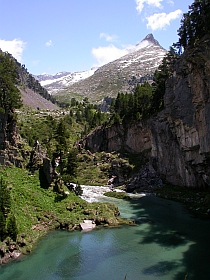 Forau de Aiguallut
© Teresa Farino
Forau de Aiguallut
© Teresa Farino
We also saw a number of different birds during the day, including Serin (Serinus serinus), Citril Finch (Serinus citrinella), Northern Wheatear (Oenanthe oenanthe), Dunnock (Prunella modularis) and Black Redstart (Phoenicurus ochruros) - the last in a family group with parent birds feeding their young. Flying around the cliffs were Choughs (Pyrrhocorax pyrrhocorax) and a total of seven Griffon Vultures (Gyps fulvus). For Annette, however, the highlight of the day was the behaviour of one particular bird - a Dipper (Cinclus cinclus) - in the centre of the sink-hole pool itself, where it was diving deep into the clear water; we could even see it using its wings like a penguin to 'fly' through the water then coming up to the surface with its catch.
A final bonus after our leisurely lunch was the extensive stand of Convallaria majalis (Lily-of-the-Valley) that Stuart found for us on a steep, west-facing stream, only a stone's throw from the car park.
28 June - Sierra de Chía
The dramatic limestone ridge of the Sierra de Chía lies to the south-west of Benasque, where a completely different
range of habitats awaited us. Leaving the main road near Castejón de Sos, we made our first stop in open woods of
Quercus faginea (Lusitanian Oak), where we found Bituminaria bituminosa (Pitch Trefoil), the curious,
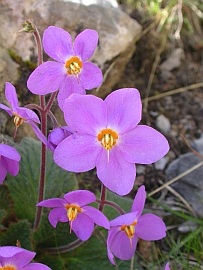 Ramonda
Ramonda
Ramonda myconi
© Teresa Farino
burnt sienna-coloured Tragopogon crocifolius and Aphyllanthes monspeliensis, (Blue Aphyllanthes) growing
in the dry, stony terrain, to the trilling accompaniment of a Bonelli's Warbler (Phylloscopus bonelli). The
distinctive, spiky grass Echinaria capitata was perhaps Arthur's find of the day, as he had never seen it before,
while Liz was delighted to finally be able to photograph Antirrhinum majus (Snapdragon) at close quarters.
Winding gradually up the hillside, through the little stone village of Chía and beyond, we could see many haymeadows below us and noticed much mowing activity in the area. The larger flatter meadows were being cut using tractors with various attachments, but we suspected that the smaller, more floristically rich meadows on the steeper slopes were probably still scythed by hand.
We explored a small bracken-edged track off the road where it was now very warm and sunny: perfect conditions for butterflies such as White Admiral (Limenitis camilla) and Provence Orange-Tip (Anthocharis euphenoides). This was an old quarry site, full of species able to withstand the dry conditions, including the ever-impressive Saxifraga longifolia, Lathyrus sylvestris, (Narrow-leaved Everlasting Pea), Ajuga chamaepitys (Ground-pine) and Teucrium botrys (Cut-leaved Germander), Lavandula angustifolia (Common Lavender) and Ramonda.
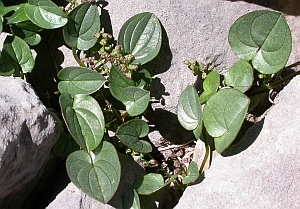 Pyrenean Yam
Pyrenean Yam
Borderea pyrenaica
© Teresa Farino
Here too we encountered the viciously spiny 'mother-in-law's cushions' of Echinospartum horridum (Echinospartum) - just coming into flower - that would soon clothe the hillsides in a mantle of yellow. Above us circled a pair of huge -winged Lammergeiers (Gypaetus barbatus); as many of us had never seen these vultures before, botanising was suspended for some time!
Climbing higher up the northern flanks of the Sierra, at about 1,500 metres we stopped once more to examine the loose limestone screes, where we found the tiny, sticky columbine Aquilegia viscosa ssp. hirsutissima, some stunning mauve cones of Campanula speciosa (Pyrenean Bellflower), the yellow bells of Ononis bubanii (Pyrenean Golden Drop) and the purple-and-white-flowered Scutellaria alpina (Alpine Skullcap). In addition to these colourful species we discovered Borderea pyrenaica (Pyrenean Yam): a most curious member of the Dioscoreaceae, whose bryony-like leaves and tiny 3-winged capsules sprawled across the screes, accompanied by the grey-leaved Crepis pygmaea (Pygmy Hawk's-beard).
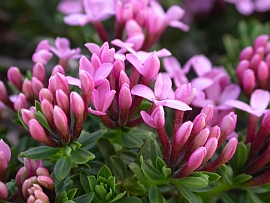 Garland Flower
Garland Flower
Daphne cneorum
© Teresa Farino
At 1,750m we found typical limestone montane plants such as Antennaria dioica (Mountain Everlasting), Saxifraga paniculata and Potentilla alchimilloides, as well as our first Dryas octopetala (Mountain Avens). Moving up to the highest point of the road, at the Puerto de Sahún (2,000m), we had amazing views of the surrounding peaks - including Monte Perdido to the west - while Egyptian Vultures (Neophron percnopterus) circled overhead and a herd of Swiss Brown cows grazed below, their resonant bells echoing across the valley.
Our delicious picnic lunch (langoustines today!) gave us the energy to make a final ascent of the rocky slopes in search of more
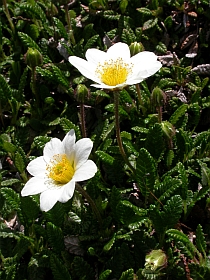 Mountain Avens
Mountain Avens
Dryas octopetala
© Teresa Farino
rare alpine plants. We climbed over a veritable carpet of Daphne cneorum and clutched hold of the tussocks of the deceptively
spiny Festuca gautieri (Spiky Fescue). Dryas octopetala became more abundant, accompanied by swathes of
Salix reticulata (Net-leaved Willow) and S. pyrenaica (Pyrenean Willow), and eventually we encountered the first
Leontopodium alpinum (Edelweiss), just coming into flower and growing together with Saxifraga oppositifolia
(Purple Saxifrage), Androsace villosa and the endemic A. pyrenaica (Pyrenean Rock-jasmine), all in very rocky
and exposed situations. Our final ascent rewarded us with a few tiny plants of Soldanella alpina, whose flowers were
just beginning to fade but were still easily recognizable, while back near the minibus, we found the striking little
purple-and-orange-flowered Linaria alpina (Alpine Toadflax).
29 June - Selva Negra/Cerler forests
The day started with an uphill walk from Cerler - looking towards the snow-capped Posets Massif - to a Pinus uncinata wood. The roadside verges and meadows were filled with a familiar glorious array of plants and butterflies, including species such as the handsome umbellifer Laserpitium siler. Where base rich flushes emerged through the cliff we found the feathery leaved, sulphur- yellow Pedicularis foliosa (Leafy Lousewort), Dactylorhiza incarnata (Early Marsh Orchid) and D. elata (Robust Marsh Orchid). The Pyrenean endemic Saxifraga clusii (French Saxifrage) flourished in profusion on a cool and dripping cliff-face.
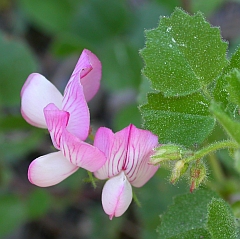 Ononis rotundifolia
© Teresa Farino
Ononis rotundifolia
© Teresa Farino
Three adult Lammergeiers (possibly two males and one female) were clearly visible on the nearby ochre-coloured cliffs, where they probably nest. These 'bearded vultures' habitually drop bones from a great height in order to feed on the marrow and then ingest the fragments; they are among the most threatened birds in Europe.
As the height increased Arctostaphylos uva-ursi (Bearberry) straggled down the banks and bushes of sticky, pink-flowered Ononis rotundifolia flourished by the side of the path, while crevices in the drier cliffs harboured some spectacular clumps of the pinkish-white Antirrhinum sempervirens (Rock Snap-dragon) and the slender, woody Fumana procumbens.
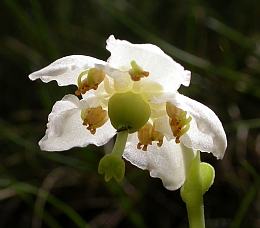 One-flowered Wintergreen
One-flowered Wintergreen
Moneses uniflora
© Teresa Farino
While we were resting in the shade, snacking on dates and cashews, Paul, John and David - who in the meantime had
forged ahead in search of wintergreens - reappeared ahead of us, urging us on to see what they had found. At their
bidding, we clambered inelegantly into an almost vertical pinewood, where we were rewarded with Pyrola chlorantha
(Pale-green Wintergreen), Orthilia secunda (Serrated Wintergreen, also known as Yeavering Bells) and, last but not
least, Moneses uniflora (One-Flowered Wintergreen, or St Olaf's Candlestick): tiny gems that could all too easily
be overlooked in the gloom.
The afternoon saw us descending below the lower limit of the Pinus uncinata along a shady woodland track from Cerler to Anciles, where the main trees were Betula pendula (Silver Birch) and Populus tremula (Aspen), with Buxus sempervirens and coppiced Corylus avellana (Hazel) in the understorey. Orthilia secunda was again seen here, growing together with Pyrola minor (Common Wintergreen), Actaea spicata (Baneberry), the attractive Paris quadrifolia (Herb-Paris) and Neottia nidus-avis (Bird's-nest Orchid).
As we emerged from this enchanting wood we encountered Campanula trachelium (Nettle-Leaved Bellflower), C. patula (Spreading Bellflower), and C. glomerata (Clustered Bellflower), after which we just had time for a quick exploration of the attractive village of Anciles, dominated by early sixteenth century stone buildings.
30 June - Ampriú
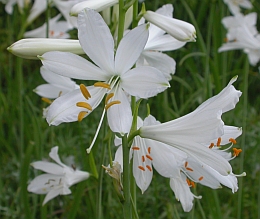 St Bruno's Lily
St Bruno's Lily
Paradisea liliastrum
© Teresa Farino
Our final day. We drove back up the road through Cerler and carried on to the ski station at Ampriú, close to 2,000m. Because the chair lift was closed until later in the month, we instead scrambled up into the surrounding meadows, where we found ourselves surrounded by great drifts of Paradisea liliastrum (St Bruno's Lily), totally living up to its name in glory and contrasting beautifully with the sheets of purplish Geranium sylvaticum (Wood Crane's-bill), drifts of pale-blue Brimeura amethystina and dozens of dark-red Nigritella austriaca ssp. iberica. A Whinchat posed on a fence-post, and a few butterflies and moths -notably Black-veined Moth (Siona lineata) and Mazarine Blue (Cyaniris semiargus) - braved the rather cool conditions.
Among many species we had already seen - some useful last-minute revision - were two tall plants of particular interest,
both tantalisingly close to being in flower: Gentiana lutea (Great Yellow Gentian) and Iris latifolia
(rather inappropriately known as English Iris). The same was unfortunately true of the stands of Veratrum album
 Pyrenean Pheasant's-eye
Pyrenean Pheasant's-eye
Adonis pyrenaica
© Teresa Farino
(White False Helleborine) that occupied rather damper areas. Virginia and Jane noticed that its shoots were covered in aphids
that were being actively milked by ants; undoubtedly the same ones that viciously attacked any human feet that paused in the
same spot for more than a second or two.
Climbing through rather coarser herbage, we encountered a single robust plant of tall Scorzonera aristata (Bearded Viper's-grass), with our first Adonis pyrenaica (Pyrenean Pheasant's-eye) causing great excitement. We also found Ononis cristata (Mt Cenis Restharrow) on drier slopes, with great patches of Pedicularis mixta combined with fleshy-pink flowered Dactylorhiza incarnata and deep purple D. majalis along the margins of the small streams that carved their way down the hill.
At this point the thunder grumbling around the peaks finally developed into a full-blown hail-storm, driving us into the shelter of the overhanging roof of the nearby ski station, where we tucked into out last picnic of the week, washed down with Spanish cava. As we loaded up the minibuses to return to base, a last Alpine Marmot piped its farewell from the top of a large boulder. And back in Benasque, the fiesta was finally drawing to a close, with a band performing on the steps of our hotel: a brilliant finale.
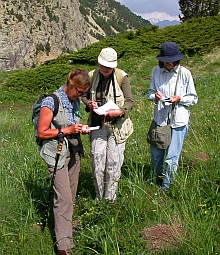 BSBI members at Ampriú
© Teresa Farino
BSBI members at Ampriú
© Teresa Farino
This report was written by Paul Bartlett,
Virginia Bird, Elizabeth Clark, Arthur
Copping, Jane and Maurice Croft, John
and Dorothy Edgington, Annette Ford,
Stuart Hedley, Shirley Watson and Mary
and David Willis, and was edited by
Teresa Farino.
It was previously published in BSBI News 109; 70-76 (September 2008).
Botanical holidays in Spain and Portugal:
Wildlife of the Aragonese Pyrenees
A Feast of Flowers - botanical holidays in the Picos de Europa
Reports of other botanical trips in Spain and Portugal:
IWT Feast of Flowers in the Picos de Europa - Trip report 2009
BSBI Botanical Tour in the Castilian Páramos - Trip Report 2009
BSBI Botanical Tour in the Sierra de Grazalema - Trip Report 2007
BSBI Botanical Tour in Western Portugal - Trip Report 2006
BSBI Botanical Tour to the Catalan Pyrenees - Trip Report 2005
BSBI Botanical Tour of the Picos de Europa - Trip Report 2004
Related information:
Read about Teresa Farino
Botany holidays in Spain & Portugal
|